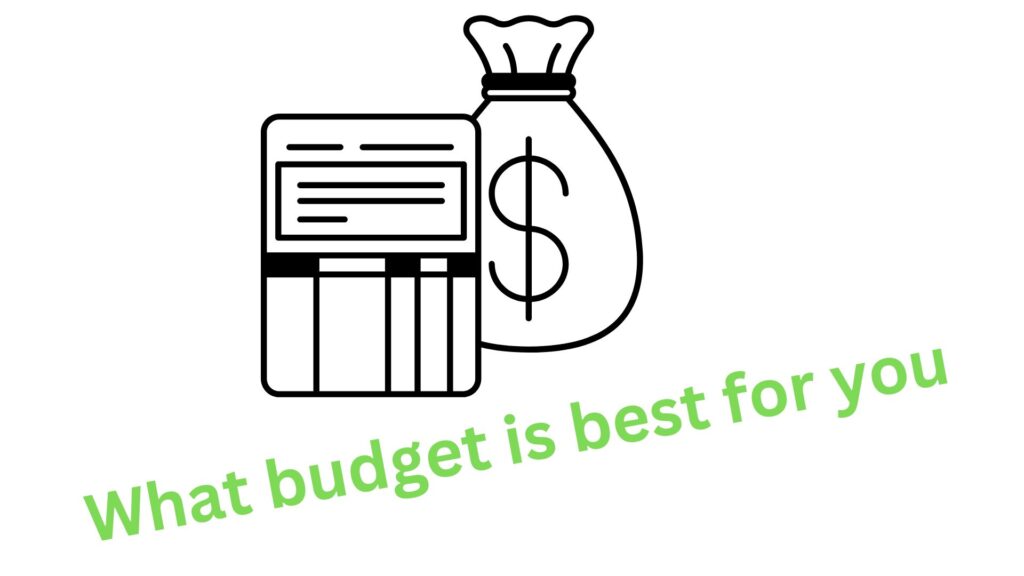What budget is best for you
Any successful financial journey requires a reliable road map, and that’s precisely where the budget comes into play. A budget isn’t just a ledger; it’s a meticulous record of your financial inflows and outflows, capturing everything from essential bills to discretionary spending. In the quest for financial stability, phrases like how to stop living paycheck to paycheck ,breaking the paycheck-to-paycheck cycle and the importance of emergency funds resonate profoundly. This financial compass, grounded in “Budgeting Basics,” tracks current spending and strategically allocates resources for future goals. Whether you aim to break free from the paycheck-to-paycheck grind or discern between necessity and excess, a well-crafted budget emerges as the linchpin for financial empowerment. Let’s explore how this fundamental tool becomes a powerful force in navigating the intricate landscape of personal finance.
What budget is best for you
Discussions about budgeting often spark the conversation about which budgeting system is best. Many are in a quandary, wondering which budget suits their unique circumstances. The 50/30/20 budget is a standard reference, but its fit varies. For some, high living expenses render this structure less effective. Others harbor aspirations to save more than the allocated 20 percent. The key lies in recognizing the individuality of financial situations.
The truth is that no budget can claim perfection because financial situations are ever-evolving. Customization is the key to fitting a budget to your present circumstances and future aspirations. If the goal is debt freedom, allocating more funds toward debt repayment is crucial. Additionally, an emergency fund stands as a pillar in this journey. Life has a way of springing surprises, and having extra funds prevents these surprises from derailing your debt-free ambitions. Consider it an integral part of your financial plan, ensuring you stay on course even when unexpected expenses arise. In essence, a customized budget tailored to your unique needs safeguards your financial journey, helping you navigate the unpredictable nature of life.
What budget best fits you?
Selecting the right budget for yourself boils down to choosing one that is functional and aligns seamlessly with your lifestyle. Customization is key — your budget should fit your unique needs and financial goals. It doesn’t need to adhere strictly to conventional percentages; it should be a practical and workable plan for you. Personal finance is not a one-size-fits-all endeavor. Reflecting on my journey with money, I realized the power of a budget lies not in its complexity but in its usability. My early budget was a simple paper list detailing monthly minimums and the corresponding amounts I intended to pay. It lacked the rigid structure of predefined percentages but was effective because it was designed to suit my specific financial circumstances. This realization underscores the importance of choosing a budget you can live with and work with.
My goal was to be debt-free
In pursuing financial freedom and the goal of being debt-free, I encountered a valuable lesson through a series of trial and error. The realization hit home: the importance of having an emergency fund as part of my financial strategy. Acknowledging that life is unpredictable, I adjusted my approach. While consistently paying the minimum towards my debt, I also allocated a portion to build an emergency fund. This dual strategy ensured that unforeseen circumstances would stay within my debt-free plan. It became evident that the security of an emergency fund is a safeguard, allowing me to navigate unexpected challenges without compromising my financial goals.
The budget today
In the present financial landscape, I’ve discovered that my budget doesn’t conform to the conventional models I’ve encountered. I’ve adopted a more flexible approach rather than fitting into a specific budgeting framework. One distinctive strategy I employ is sinking funds. Unlike traditional budgeting, sinking funds involve proactively saving for specific future expenses. I tap into these funds when needed, allowing for a dynamic and adaptable budgeting process tailored to my unique financial journey.
Don’t stress over the budget name
Choosing the perfect label for your budget might seem like a daunting task, but in reality, the name is secondary. What truly matters is the clarity it brings to your financial picture. The key is understanding where your money flows and ensuring every penny aligns with your financial goals. The act of tracking, not the title, empowers you to steer your money intentionally toward the destinations you’ve set on your financial journey. So, don’t stress over the budget’s name; focus on the direction it provides for your financial well-being. This embodies the essence of “budgeting basics,” where the simplicity of tracking leads to financial empowerment.
Conclusion
Mastering the art of budgeting goes beyond just tracking expenses; it’s about embracing “Budgeting Basics” to steer your financial ship. You gain control over your spending by knowing how much you’ve allocated for each category. The strategy is straightforward: you halt spending when a category runs out of funds. However, this simple approach requires careful planning. It’s about translating your financial aspirations into tangible, achievable goals and ensuring that every dollar has a purpose. The budget becomes a dynamic tool for tracking expenses and steering your financial ship toward the destinations you’ve set on your unique journey.

